One thing is for sure, we are fully into the foraging season now. I’m starting to get really excited for all of the wonderful foraging that will be happening soon, especially berries! In this post I will be talking about foraging for Oregon Grape, which isn’t technically a grape at all, but a bush in the barberry family that has edible berries and medicinal properties.
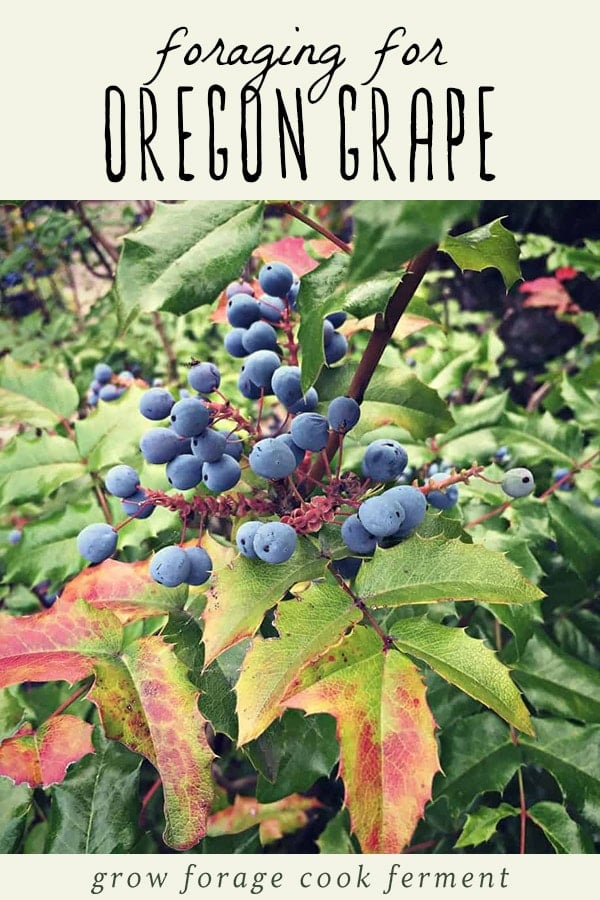
Want to save this post for later?
Wildcrafting Weeds
If you want to learn more about the edible and medicinal weeds that surround us and how to use them, check out my eBook: Wildcrafting Weeds: 20 Easy to Forage Edible and Medicinal Plants (that might be growing in your backyard)!
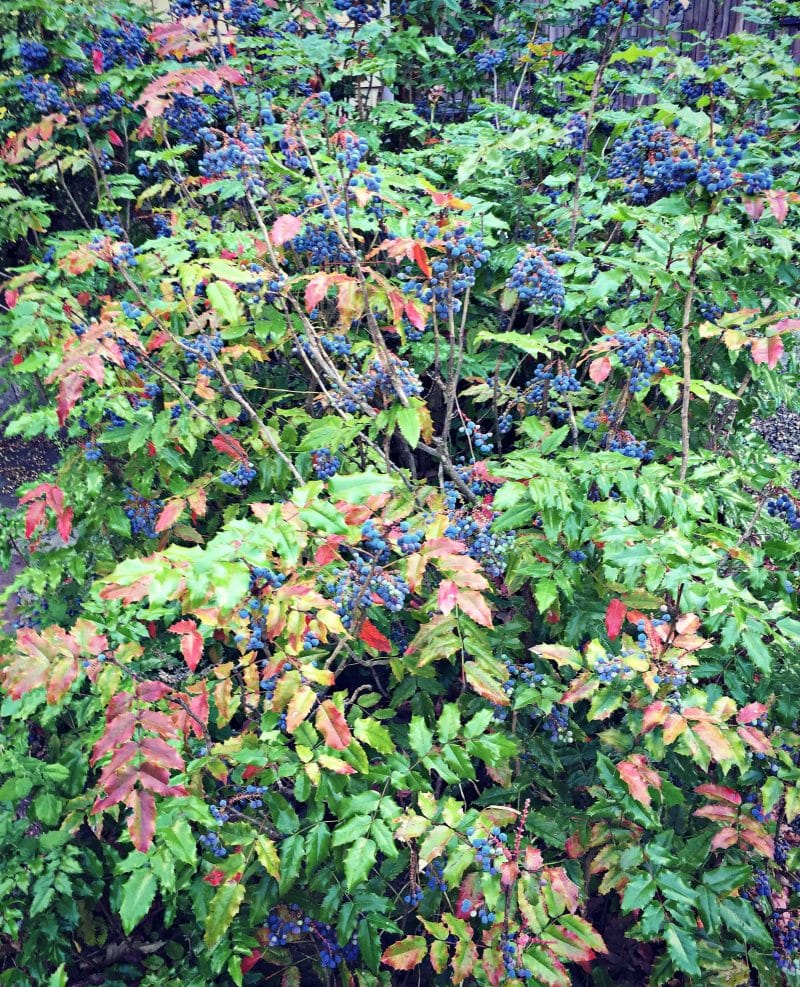
Foraging and Identifying Oregon Grape
Oregon Grape (Mahonia spp.) is native to Oregon (hence the name) and other western states.
It is in the barberry family and has spiny leaves similar to hollies. It is sometimes called Oregon grape-holly, although it’s not a grape or a holly!
There are several different species of Oregon Grape, the tall and the low seeming to be the most common.
The tall variety (Mahonia aquifolium) is what is most commonly used in yards for landscaping purposes, and we even have some in our yard.
The low variety (Mahonia nervosa) can be found out in the woods fairly easily as it tends to be more wild.
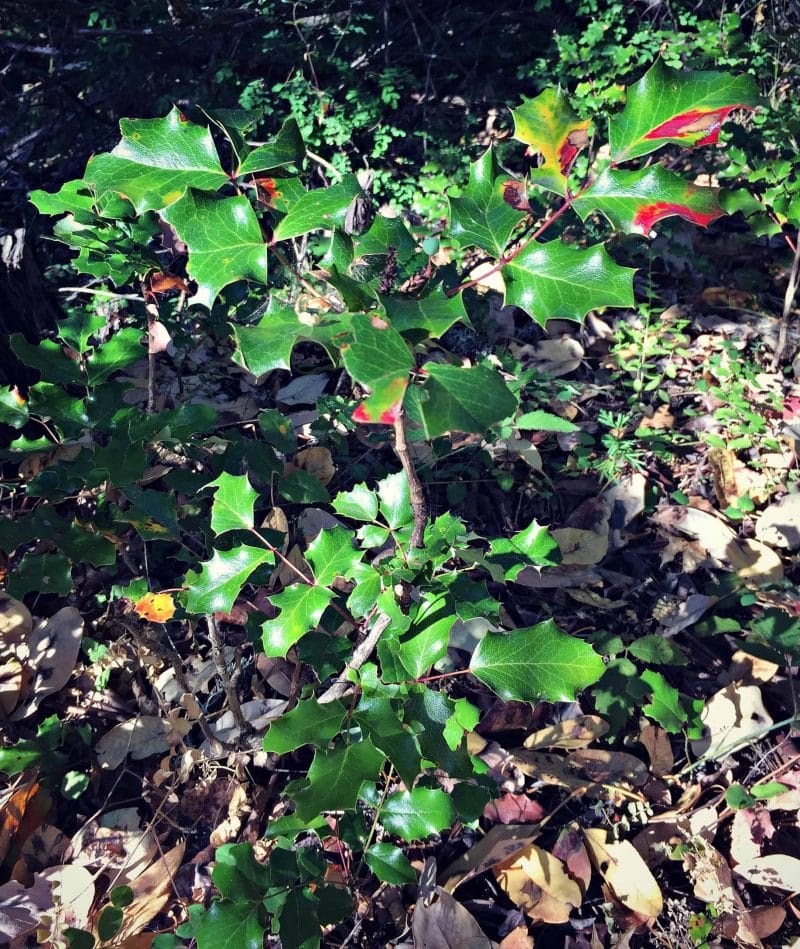
Oregon grape berries are not grapes nor do they taste anything like grapes. In fact, they are very tart, but edible nonetheless. They ripen from late June through August, depending on your location.
The berries themselves actually look quite similar to juniper berries, which also have a whitish “bloom” coating.
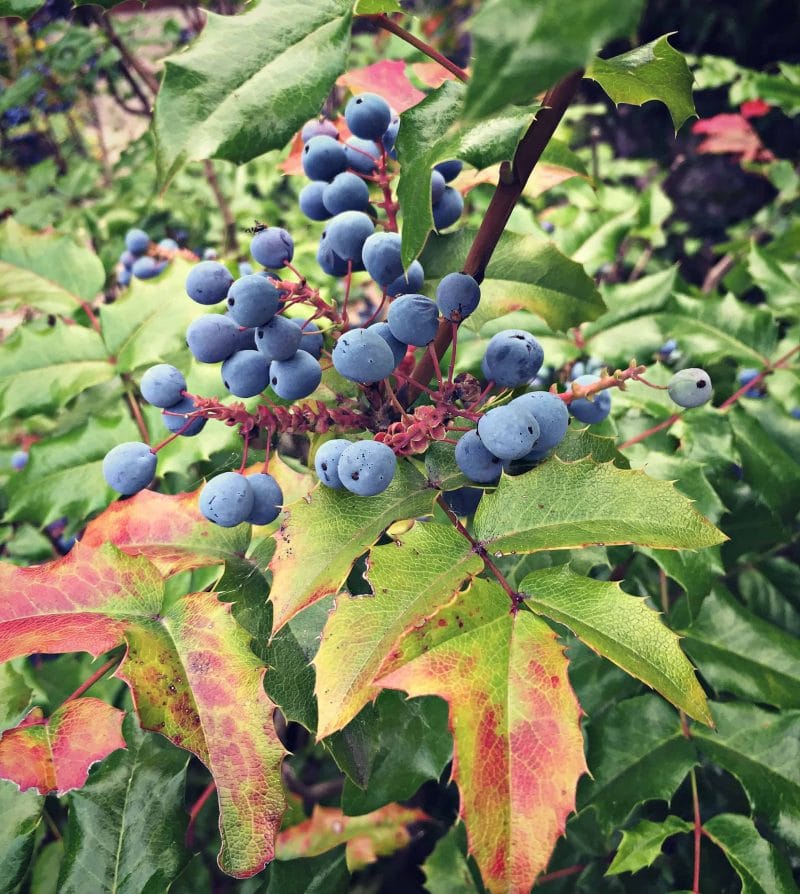
Harvesting and Using Oregon Grape
The best way to use the berries is to make jam, pie or wine. Anything where sugar is added! I’m thinking an Oregon Grape mead would be quite nice.
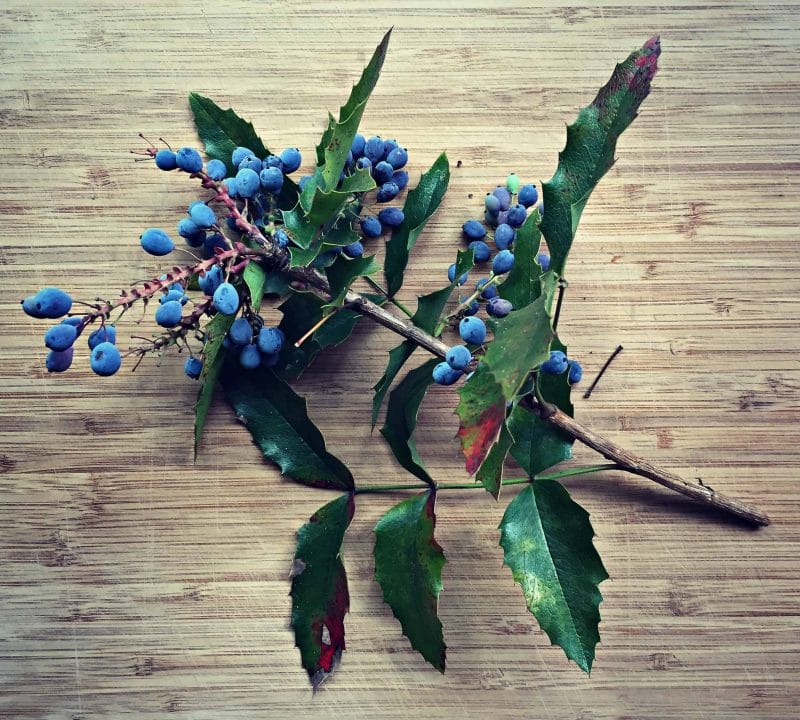
Even with the spiny leaves the berries come off their stems quite easily, which is nice. It didn’t take long for me to get a small bowl full.
Oregon grape is on the United Plant Savers plants to watch list, so care needs to be taken when harvesting. Never take the entire plant and be mindful that you are leaving enough for it to reproduce.
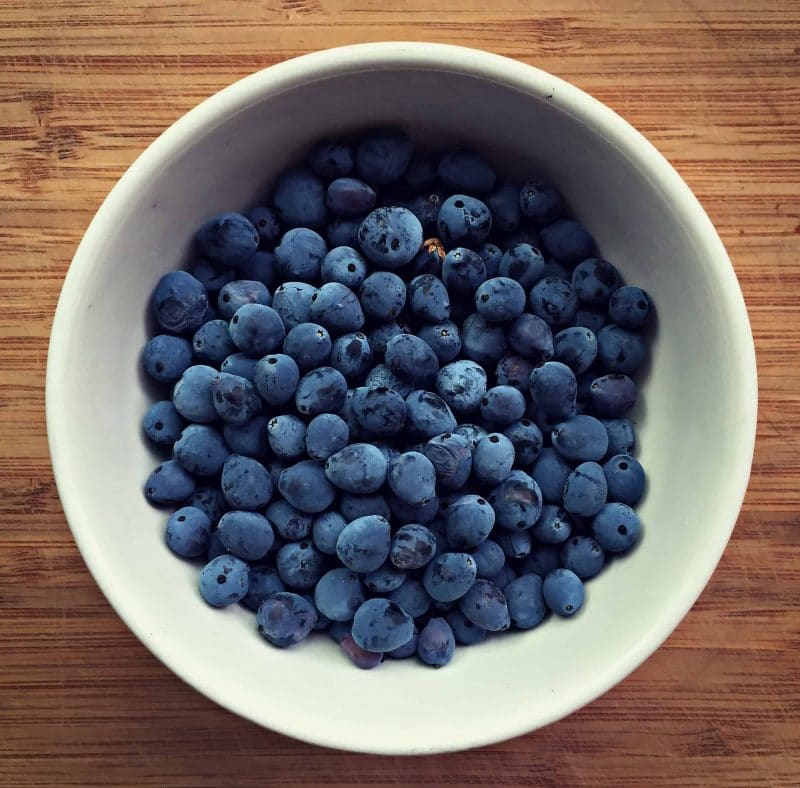
Medicinal Uses of Oregon Grape
Besides having edible berries, Oregon Grape is also well known as a medicinal plant.
It contains the compound berberine, which is mainly found in the roots and bark of the plant. Berberine has antimicrobial, antiviral, antifungal, and antibiotic properties.
Berberine is also the main medicinal coupound found in goldenseal root, and Oregon grape root can be used similarly.
In the low wild variety you can pretty much only get berberine from the roots, but in the tall variety the stems are much larger so you can shave off the bark to access it. It has a noticeable yellow color.
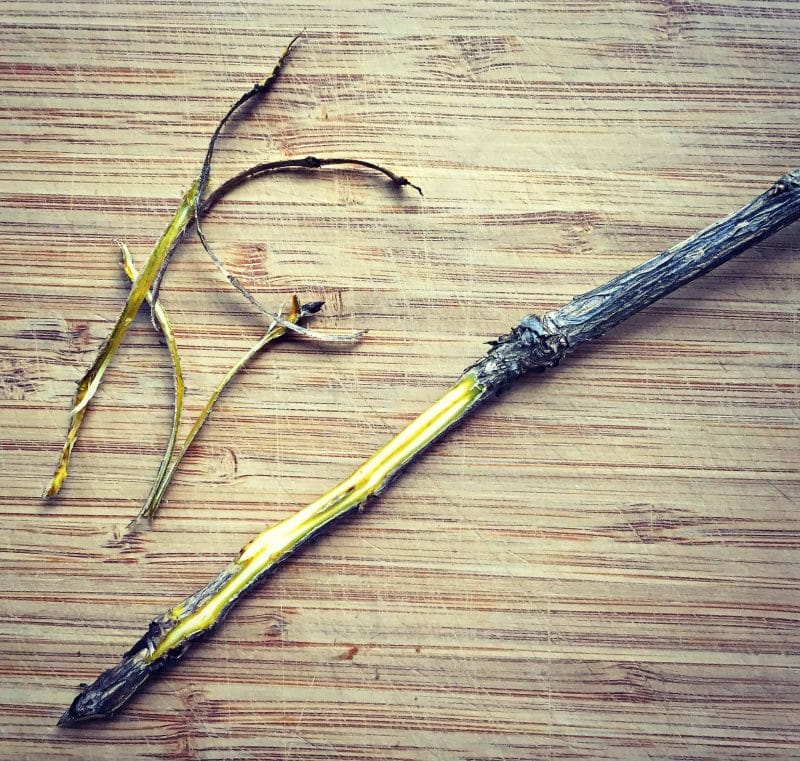
You can use the roots and stems to make a tea, tincture, oil infusion, or salve.
If you don’t live in western states or can’t seem to find any wild Oregon Grape in your area, you can always order the root from Mountain Rose Herbs.
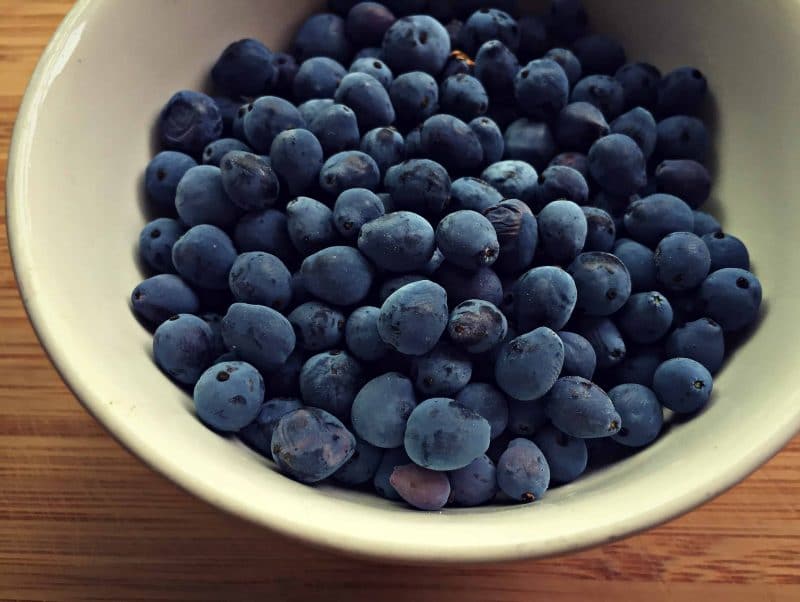
For now, though, I’m going to think about what to do with these awesome berries!
There’s a lot more where these came from, and I’m thinking maybe a jam. I would also love to play around with using the roots and stems in a tea or oil infusion for salve.
What a wonderful and highly useful plant!

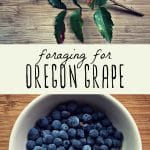

I just watched a video that mentioned by adding grapeseed protein (or pea protein) in multiplies the bioavailability by almost ten times. They sell the product as Berberine phytosome.
I wonder if you could grow this in Texas?
I just did a quick search: “growing zone for Oregon Grape” and found it to be 5-9. Depending on where you are in Texas and what zone that is would determine if you can grow it.
Plenty of Oregon Grapes in my neighborhood. I’m going to try making jam with them this year
as kids we ate the blossoms and tender new leaves. sour flavor but we loved it.
I ate the blossoms as a kid too and tried the berries. dad said I’d need too much sugar to make decent jam but i’ll try it this year anyhow
I just found 2 of the low growing Oregon Grape shrubs in the woods behind my house. I live in Tennessee… ; )
My free range chickens strip my bush of berries very quickly, even trying to fly a bit to get the higher up berries!
how do I make berberine for my diabetes so I can quit buying berberine? I take it three to four times a day.
Hi there. I don’t believe this is something you can make it home, unfortunately.
I have been making wine from Oregon Grapes for about 5 years now, and it always turns out perfectly. By that I mean, it has a very pungent, dry taste, but high alcohol content. I discovered that this wine is a perfect base for making Sangria! Give it a try.
Interesting! I haven’t tried making wine with Oregon grape, but that sounds fantastic. Thanks for the tip!
Hi
My name is Steve Coles.
I noticed your comments while searching for a recepie on how to make wine from the Oregan Grape/Mahonia Berry. I’ve searched everywhere but with no success. Here in England Oregan Grape is not widely known or grown.
Please would you mind sharing your recepie. I would be most greatful.
Kind regards
Steve Coles
Hello
I’ve been teaching myself the art of ‘ self – taught ‘ wine making. I’ve also taught myself foraging.
I came across an Oragan Grape Bush last year whilst out walking. Although there were no recipes I attempted to make some wine Oragan Grape wine using the same method as though I were making elderberry wine. This is my first attempt and it tasted ‘ earthy’. Please could you let me know how you made your wine. Recepie a d method please.
I really would appreciate it very much.
Kind regards
Steve Coles
Hi Steve. I’ve never made Oregon grape wine, so I can’t give you an exact recipe, unfortunately. It looks like a few options online though!
I have been told by local ecologists in my area that the more shrub-like Tall Oregon Grape (Mahonia aquifolium) takes longer to grow, and is therefore becoming over-harvested for the root due to growing popularity. Evidently, the trailing Oregon Grape (Mahonia nervosa) grows faster and has more extensive, rhizome systems- making it the more ecologically sound species for harvesting.
As small children we were always told that they were poisonous. Someone told me recently that you have to cook them so you don’t get poisoned.
They are edible raw, just very sour. They do no need to be cooked first.
Have you find any information regarding the sugar content of the berries? They’re very tart, but I’m curious how they quantitatively compare to domesticated berries.
Are the Oregon grape seeds edible or poisonous? I have them mixed with grape seeds. I was thinking about grinding them all together to a powder. Is that a mistake?
I’ve accidentally chewed up an Oregon grape seed and it had a very sharp bitter flavor. Idk what reg grape seeds taste like or what you’re after, but I say don’t do it.
I make a jelly from the Oregon Grape that is fabulous, great taste, not to sweet. We strain it so the no consequently, no seeds. I have considered making a jam from it. However, I have been told by a knowledgable person, who is not an expert, that the seeds may contain something that could be considered harmful to children and others. If the roots and stems have Berberine, is it possible the seeds also contain Berberine?
Is there a way to “plant back”, or propagate the plants if I do pull one or two of them to utilize their root?
Native Americans made a practice of cutting just one root per plant, avoiding the central root (taproot) so the plant would live. There is no reason to use the entire plant, especially since there are typically several growing together in a “family” that can be utilized in a conscientious, respectful way.
Thank you for the information I have a great one out in the garden
When is the best time of year for harvesting Oregon Grape stems and roots? I am in NE Oregon, for reference. I know there is a bit of a weather difference. I would like to cause the least amount of damage to the surrounding plants, and get the most benefit from the Oregon Grape. Thank you!
For roots, you want to harvest in fall, when they have stored the energy to get them through the winter. The next best time is in early spring, before they start using that energy to grow.
I’ve been making an Oregon Grape/ Salal jelly for years. I always look forward to harvest season for these lovelies! Great for meats as well as breads. Great article!
I always thought these were poisonous!!
That is what I had been led to believe – perhaps by people who wanted them all to themselves!!
make an Oregon Grape Jelly. It makes a great accompanyment for wild game especially roast venison and moose.
Can I get them sweeter when I freeze them for a while? And can I use them for Wild Yeast …?
Thanks,
Alex
Would probably work great for wild yeast! Did you try it?
What did you end up doing with the berries? Did you make mead? how did it turn out?
We ended up just drying a whole bunch of them for future use. I made an elderberry mead, though!
I love your articles but I feel compelled to provide you with a slight correction to your information. Oregon Grape are not members of the Holly family. Mahonia ‘aquifolium’-‘nervosa’-‘repens’-‘fremontii’ AKA Berberis ‘aquifolium’-‘nervosa’-‘repens’-‘fremontii’ are native to the western United states and are members of the family Berberidaceae or Barberry. Although sometimes it is referred to as Oregon Grape “holly”, it is not taxanomically related to actual Holly or Ilex which is the plant family Aquifoliaceae. All of the Mahonia have edible berries, roots, and leaves and all of the Holly-Ilex have toxic berries, roots, and leaves. There is also a non-native “grape” from China called Mahonia ‘bealei’, it is also an edible berry but is considered a noxious weed in the US.
Thank you for letting me know, and thanks for the great info! I’m not sure where I got my info, but clearly it was wrong. I will edit the post to reflect that.
I don’t think all of the Ilex genus is toxic, or at least part of some of the plants aren’t. The leaves of mate (Ilex paraguariensis) and guayusa (Ilex guayusa) are drunk as tea. And apparently the leaves of English holly used to be used medicinally.
Toxic doesn’t mean non medicinal. If medication was benign it wouldn’t do anything. It’s all toxic therefor the risk of overdose.
I’m so happy to find this! I only recently discovered that these “grapes” are edible, but I hadn’t seen any documentation of folks actually using them. Thanks for the encouragement!
Last fall I was collecting rose hips when I found some Oregon grapes that were over-ripe and falling off the bush. I couldn’t just leave all of them there (there were quite a few) so I took them home with my rose-hips and made a gallon of rose-hip/Oregon grape wine out of them. It was so good that I’m hoping to do the same again this year. I’m sure Mead would be a wonderful option too.
that sounds very good! Could you please forward me your recipe and method for making this wine? I have lots of both and would love to try to make a gallon! Thanks! my email julienorvan@gmail.com
Take care and happy mead making! Julie
Hi just read your post I would love to make wine or name out if my Oregon bush berries please could u email the method please I’ll let you know how I get on :-)
Those grapes look so good!! they remind me of the huckleberry (wild blueberries)
When my oldest was young I taught him how to forage berries it the woods, showing him
that a round circle on top where you pick it makes it edible and non poisoned. If the berry comes straight off a stem=poison. These grapes look so similar to huckleberries. we would be camping and Jason and I would head to the woods and beat the bears to their
treat and come back with blue cheeks and berry stains everywhere!!!. Those were the days!
It seems freezer jam would be the best, but I also think a syrup for your yummy sour dough
pancakes!!! I would never get a whole bowl into my house,….. ;)